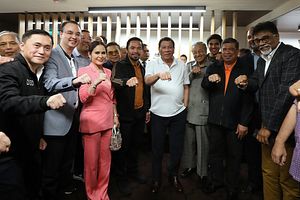Last week, Philippine President Rodrigo Duterte met with visiting Malaysian Prime Minister Mahathir Mohamad for the second summit meeting between the two leaders in less than a year since Mahathir reassumed the premiership after a shock election win in May. The meeting spotlighted some of the ongoing activity in the bilateral relationship, which both sides continue to try to develop amid their wider domestic and foreign policies.
As I have noted before in these pages, Malaysia and the Philippines, both members of the Association of Southeast Asian States (ASEAN), have long tried to forge greater cooperation across a range of economic, security, and political areas and deal with a range of shared traditional and nontraditional challenges – including terrorism, piracy, and illegal fishing – in spite of the differences that remain between them. That has continued on in recent years amid lingering irritants and wider challenges, be it the unresolved issue of the Philippine claim to Sabah or the rising terrorism threat that has motivated trilateral patrols between the two countries and Indonesia in the Sulu Sea (See: “What’s Next for Sulu Sea Trilateral Patrols?“).
Mahathir’s shock victory in Malaysia’s election last May had raised the question of how Malaysia-Philippine relations would fare under the new Pakatan Harapan government over the next few years. And we have begun to see signs of how bilateral ties are developing, with ongoing collaboration as well as meetings at various levels, most prominently the summit meeting between Mahathir and Duterte last July.
Last week, the bilateral relationship was in the headlines again with the visit of Mahathir to the Philippines. Mahathir was in the Philippines for a two-day official visit that was made at the invitation of Duterte at an interesting time for the domestic and foreign policies of both countries. Domestically, this is a mid-term year for Duterte; it’s also a key year in the so-called transition process in place between Mahathir and his former deputy prime minister turned opposition leader turned prime minister-in waiting, Anwar Ibrahim (See: “Where is Malaysia’s Mahathir-Anwar Transition?“). And foreign policy-wise, both Mahathir and Duterte are seen as key voices in the region in the continuing conversation about how Asia approaches both China and the United States amid intensifying geopolitical competition.
The visit consisted of a series of events that addressed a wide range of issues. Mahathir and the Malaysian delegation met with Duterte and the Philippine side at Malacanang for a summit meeting along with other engagements. Both sides emphasized that their discussions dealt with matters across the bilateral relationship, including the promotion of tourism, facilitating more trade and investment, including in areas such as infrastructure in line with Duterte’s Build Build Build program, enhancing health and education, protecting the welfare of Filipinos and Malaysians, and boosting collaboration in ASEAN.
While the official accounts of the meetings emphasized the comprehensive nature of the issues actually addressed, the headlines were focused more around the security and geopolitical issues surrounding the two nations. On security matters, Duterte noted in a joint press statement the full range of matters that both sides considered important, including terrorism, piracy, and transnational crimes such as the illegal drug trade. Both leaders referenced advancements on the trilateral patrols together with Indonesia, which continue to take shape. But of particular note was the issue of the southern Philippines, with Duterte acknowledging Malaysia’s important role in assisting with the pursuit of peace and development in the region and Mahathir reaffirming his country’s desire to continue to help in any way possible.
In terms of geopolitical issues, there was mention of a discussion of matters such as the South China Sea and the Korean Peninsula, even though no further specifics were publicly disclosed. Some media outlets also picked up on Mahathir’s more colorful comments regarding the United States and China, including the negative implications of borrowing large sums of money from Beijing as well as China’s regional role relative to those of other Western powers.
As I have noted before in these pages, while Mahathir and Duterte are both known for their hyperbolic statements on geopolitics, including on the United States and China, that make for good headlines, it is more useful to look at what their countries actually end up doing, rather than what they are saying (See: “How Far Does the China Belt and Road Pushback Really Go?“). That applies to the wider bilateral relationship too: even as the two leaders have been keen to emphasize their personal ties and pursue lines of collaboration, as it has been in the past, the future of Malaysia-Philippines ties will also rest in how both sides are able to actually implement the ideas they are advancing as well manage challenges and crises that can unexpectedly arise.

































